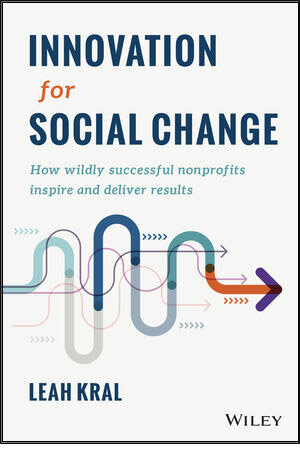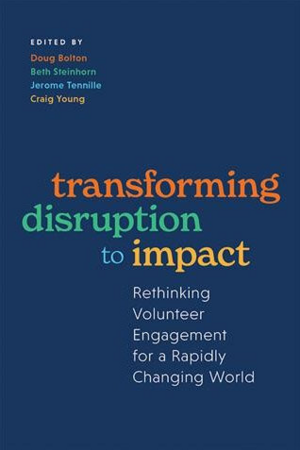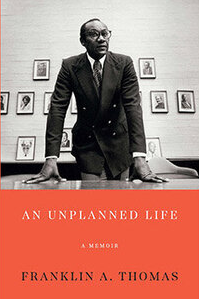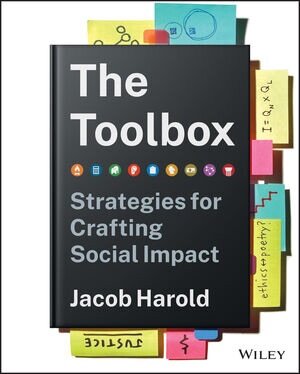Innovation for Social Change: How wildly successful nonprofits inspire and deliver results
Running a nonprofit is no simple task. Time and again, nonprofit leaders find themselves overwhelmed without time or space to ask, “What could be better?” and “How can we make that happen?” Leah Kral’s Innovation for Social Change: How Wildly Successful Nonprofits Inspire and Deliver Results, provides the necessary reminder to anyone managing a nonprofit that innovation and good organizational design is an essential component of an effective nonprofit. Through practical examples and useful frameworks, this book encourages nonprofit leaders to trust creativity, ask good questions, and, most importantly, not be afraid to do things differently.
Kral is the senior director of strategy and innovation at the Mercatus Center at George Mason University, and her years of experience supporting institutions through out-of-the-box thinking and research come through in her book. She provides six fundamental principles to support nonprofit leaders in taking innovative actions and explains them through real-life examples of strategies from nonprofits and social entrepreneurs.
According to Kral, innovation can and should take place across internal process improvements, organizational culture, program strategy, fundraising models, and technology. Organizations that adopt innovation are the ones that “endure, that are built to adjust and continue to be impactful as the world changes around us.”
Some of the “wildly successful” stories shared in Innovation for Social Change may seem at first like unreachable goals, especially for those of us with no previous entrepreneurial experience. However, Kral walks us through those stories, defining actionable steps that anyone can grasp and, in turn, replicate. Whether you’re working at the scale of the Mayo Clinic or a local elementary school, the hands-on techniques she describes can be applied. She reminds us, “sure, innovation can be big, like creating a civil rights movement, but more often than not it happens on the margins. Seemingly small innovations open the way for our time, energy, and resources to be put to better use elsewhere.”
After breaking down the why behind innovation, Kral outlines the four stages of the process of cultivating innovation: sparking innovative ideas, transforming them into action, building innovation into organizational DNA, and bringing your own unique spin to innovation.
We’ve all participated in the first stage–participating in a brainstorm, coming up with new ideas, and rushing them to action. But more often than not, those ideas aren’t fully thought through and fall flat (and that’s ok–throughout the book, Kral offers numerous stories of failure and how we can learn from them). To support the ideation stage, we are introduced to design thinking exercises and three key questions: “What’s desirable? What’s feasible? And what’s scalable?”
Without naming them as such, the methods shared are participatory and proactive in nature, requiring collaboration, radical listening, and ecosystem thinking to take ideas forward.
As simple as those questions may seem, I found myself gripped by the intentionality with which one should uncover what’s desirable. Surfacing unmet needs requires a lot of questioning and proactively seeking the engagement of those at the center of the issue. Too often are solutions developed that miss the mark of what communities actually need. Without naming them as such, the methods shared are participatory and proactive in nature, requiring collaboration, radical listening, and ecosystem thinking to take ideas forward. For example, Kral introduces the Six Sigma exercise of asking “Five Whys” to get at the heart of an unmet need. By asking “Why?” to every consecutive answer one may hear, we are more likely to uncover the root cause to an issue.
The book also addresses culture and the context nonprofits work in, and how they can help or hinder our ability to build an ecosystem for innovation. Organizational design and the roles we are assigned matter. Mistakes, roadblocks, and inefficiencies are more likely to occur when navigating organizational structures and processes we do not like. So how do we develop better ones? The challenge is that positive culture is a product of both intentional design and spontaneous occurrence. Kral distinguishes between the influences of “workplace culture as intentionally designed top-down rules and bottom-up informal norms that come through individuals” and offers strategies for cultivating both. For example, organizational principles like values that are proactively communicated help set the tone for a positive culture, but individuals (usually not those at the top) also can act as culture ambassadors.
In addition, Kral points out that an entrepreneurial environment cannot exist unless team leaders “walk the talk” and create a culture where people feel safe to challenge status quo and engage in uncomfortable conversations, which does not develop by accident. To that end, she offers examples of questions and feedback mechanisms that leaders can implement to ensure that team members feel free to challenge assumptions and develop their ideas. She even walks through who should be empowered to make decisions and when they should be top-down versus bottom-up, arguing candidly that most of the time, executive leadership and managers should get out of the way to facilitate better performance and better ideas. After all, she writes, “creative and collaborative work cultures matter for better outcomes” and, drawing on real-life examples, “even to save lives.”
Kral points out that an entrepreneurial environment cannot exist unless team leaders “walk the talk” and create a culture where people feel safe to challenge status quo and engage in uncomfortable conversations, which does not develop by accident.
The final section of the book guides readers through stories about entrepreneurial thinkers and ways in which one can create plans for themselves to cultivate our innovative and effective best selves. While the stories are inspiring, the necessary characteristics are familiar–passion, empathy, curiosity, and courage–traits we are all capable of and can strengthen through practice.
The book covers everyday nonprofit activities like how to conduct a debrief, evaluate actions, negotiate with stakeholders, and navigate donor relationships. What feels unique is how each activity is presented and paired with creative and pragmatic exercises and questions to take our thinking about how they can happen to the next level.
I would also argue that the exercises can be practiced by anyone engaging in social change work. Whether you are a nonprofit leader or staff member, this book offers useful approaches for harnessing your potential for innovation and new ideas. If you’re worried you don’t have enough resources (time, money, staff) to pursue innovative ideas, this book will put those concerns to rest. Kral deploys accessible exercises and sound reasoning to offer a deeply convincing and inspiring argument for why a sector working to address the world’s ever-changing needs must break out of its status quo.
Sarina Dayal is senior research specialist at Candid.










